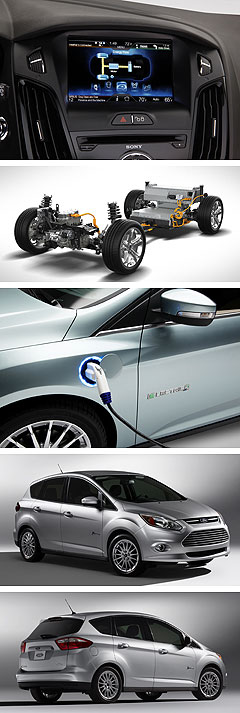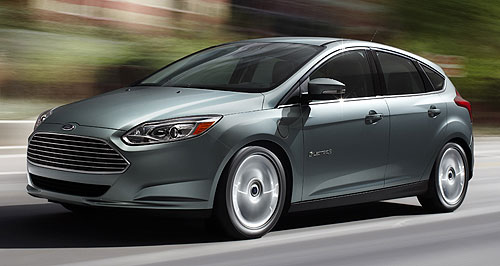Future models - Ford - Focus - ElectricFord Oz to electrify – eventuallyElectrifying: Ford will not launch the Focus EV in Australia before 2013, giving rivals like Nissan, Renault and Mitsubishi a head start in the EV sales race. Focus Electric will be Ford Australia’s first EV, but it won’t come next year21 Jun 2011 THE FIRST electrified Ford to be sold in Australia will be the Focus Electric, but it won’t join high-tech rivals from Holden, Nissan, Renault or Mitsubishi in local showrooms next year. Ford is currently formulating its vehicle electrification strategy for the Asia Pacific and Africa region, including Australia, and has five new hybrid or electric vehicles from which to choose. The Blue Oval announced in the US on June 9 it will invest $US135 million and add 220 jobs at three Michigan plants to produce five electrified models. They include the Focus Electric, C-Max hybrid, C-Max Energi plug-in hybrid, the all-electric Transit Connect van and a fifth, as-yet-unnamed model, which could be a plug-in hybrid version of the compact SUV that will replace Australia’s Escape and Europe’s Kuga, as previewed by the Vertrek concept. Ford said it will triple North American production of electrified models to more than 100,000 vehicles by 2013 in its drive to make a quarter of its vehicles run at least partly on electricity. The Blue Oval’s electrification plan will be led by its first all-electric vehicle, the Focus Electric, which will be released in North America this year before being rolled out across Europe. Ford has confirmed to GoAuto the Focus EV is almost certain to be the brand’s first electrified vehicle in Australia, but its local release remains dependent on the rollout of EV infrastructure and the establishment of a solid business case based on sufficient demand.  Left: Ford Focus EV. Below: Ford C-Max Hybrid. Left: Ford Focus EV. Below: Ford C-Max Hybrid.“We’re working through, as Asia Pacific and Africa as a region, what is going to be our electrification strategy and Focus Electric is the obvious vehicle to launch that with,” said Ford Australia public affairs director Sinead McAlary. “Obviously we’ve got the Focus Electric that is going on sale in North America later this year and then in Europe. “Because the regular Focus is going to be sold in all those markets, we have to work through if that makes sense, when it would make sense and whether the technology here in terms of the support systems would be in place, such as recharging stations and the like. “All that has to happen and so it would be a long way away but it’s on our radar. “It’s something there’s a lot of work to be done on – not just from us, but form the Australian government and the electricity industry, and customers have to say they want it in enough volume as well.” Renault this week announced it will enter the Australian EV race with its all-electric Fluence ZE small sedan, which it has committed for local public release by the end of 2012. The news follows last week’s confirmation that Mitsubishi’s pioneering i-MiEV will be priced at $48,800 plus on-road costs when the battery-powered mini-car becomes publicly available here in August. Tesla’s ground-breaking Roadster joined at least two homegrown aftermarket EVs to become Australia’s first factory EV in March, when it was launched with prices from $222,995 drive-away, but has so far attracted only a handful of buyers. Before the plug-in Fluence arrives, Australia’s first mainstream EV will be followed by at least two other electrified small cars in 2012. Nissan Australia says its all-electric Leaf hatchback remains on target for launch here in April, while Holden has committed to releasing GM’s plug-in hybrid Volt liftback in the second half of 2012, but won’t say exactly when. However, the Volt is expected to be more expensive than the i-MiEV, as well as the Fluence ZE and Leaf EV, both of which could cost as little as $30,000 here, excluding battery costs. Toyota Australia is also considering the local release of a plug-in version of the world’s most established and best-selling hybrid, the Prius, which goes on sale in Japan and the US next year. Toyota has promised to release two all-new hybrid models in Australia next year and will show the compact Prius C and five-seat Prius V people-mover – which will also spawn a seven-seat version called the Prius Plus – at next week’s Melbourne motor show. As part of Ford’s US electrification strategy, Ford said it will produce only hybrid versions of the five-seat C-Max people-mover in the US, canning plans to release only a conventionally powered seven-seat version of the Focus-based C-Max in North America in 2012. Sales of the latest C-Max and Grand C-Max have soared in Europe, where orders have topped 100,000 since its launch there late last year and this year UK sales have doubled over the model it replaces. Unlike in the US, Europe’s C-Max is available with petrol and diesel power. To meet demand, Ford has increased C-Max production at its plant in Spain, from where Australia’s version would be sourced if the C-Max were to be sold here, but Ms McAlary said no such plan exists. “Our position on C-Max hasn’t really changed – it’s a segment of the market that we don’t think is big enough at this stage. “We obviously have other family vehicles that cater to Australian consumers quite nicely, but we never say never. “If the market was changing and we thought there was enough opportunity there for us to make a market in that segment… but at this point we’re not there.” Ford currently sells about 35,000 electrified vehicles annually, including the Fusion Hybrid and Escape Hybrid, but said it expects the hybrid systems it will offer from next year to be 30 per cent less expensive than the one that was introduced on the 2010 Ford Fusion. Ford said C-Max pricing would be kept down because much of its hybrid system was designed and engineered by Ford, which will also assemble the system. While the hybrid transmission in Ford’s current Fusion and Escape hybrids and the Lincoln MKZ are supplied by Aisin in Japan, Ford’s new hybrid transmission was self-developed and will be produced from early 2012 in Detroit for global markets. “This is a big deal for us because we are seeing a huge growing appetite for fuel-efficient green vehicles,” said Ford’s group vice-president of marketing, sales and service, Jim Farley, on June 9. “The number of people indicating fuel economy is the main reason continues to rise. “This is a better opportunity than introducing a gas engine, seven-passenger C-Max in North America. This decision shows how flexible the One Ford strategy is, that we can change with market conditions. “Whether people want a hybrid, a plug-in hybrid or full battery electric vehicle, we have a family of vehicles for them to consider, providing a range of options to best meet their needs and support their driving habits and lifestyles.” In other Ford production news, the company’s passenger car joint-venture in China, Changan Ford Mazda Automobile (CFMA), broke ground for its second engine plant in Chongqing on June 16. The $US500 million investment will more than double CFMA’s annual engine production capacity in China to 750,000 units when it comes online in 2013. The new plant will make engines for a range of Ford vehicles produced and sold in China, and follows the announcement of a new $US300 engine plant to be built with Ford’s Chinese commercial vehicle partner Jiangling Motors Corporation (JMC) in Nanchang. Ford signed an MOU in May to build its first transmission plant in the country, also in Chongqing, with an initial annual capacity of up to 400,000 units. Ford’s second passenger-car assembly plant in Chongqing will begin production early next year, starting with the new Focus that goes on sale in Australia in August. Ford announced in April it will launch 15 new vehicles to China by 2015, when the number of employees and dealership outlets it has there is expected to double. Apart from revealing its C-Max hybrid plans for the US, Ford also announced on June 9 that it expects its global sales to increase 50 per cent by 2015 to around eight million vehicles a year – up from 5.3 million last year – on the back of continued growth in China and the rise in popularity of small cars.  Read moreFocus pricing
Motor industry news |
Click to shareFord modelsResearch Ford Focus pricing
Motor industry news |















Facebook Twitter Instagram